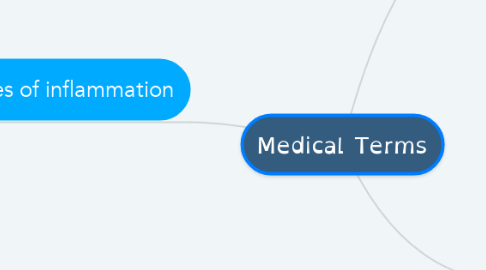
1. Prefix
1.1. It is a vital process by which living tissues react as a protective response to localize and eliminate metabolically altered cells, foreign particles, microorganisms or antigens resulting from the injury.
2. Suffix
2.1. Physical
2.1.1. heat
2.1.2. cold
2.1.3. irradiation
2.2. Chemical
2.2.1. Acids
2.2.2. Alkali
2.3. Infective
2.3.1. Bacteria
2.3.2. Viruses
2.3.3. parasites
2.3.4. Fungi
2.4. Immunological
2.4.1. Antigen antibody reaction
2.5. Other causes leading to cell injury
2.5.1. Vascular
2.5.2. Hormonal
2.5.3. Metabolic
2.6. New mTopic
3. Types of inflammation
3.1. Acute inflammation:
3.1.1. Definition
3.1.1.1. inflammation of sudden onset and duration
3.1.2. Characterized by
3.1.2.1. Rapid onest
3.1.2.2. Short duration
3.1.3. Mechanism
3.1.3.1. V.D and leukocyte emigration, formation of I.E
3.1.4. Signs and Symptoms
3.1.4.1. Local
3.1.4.1.1. Hotness
3.1.4.1.2. Redness
3.1.4.1.3. Swelling
3.1.4.1.4. pain
3.1.4.1.5. Loss of function
3.1.4.2. Systemic
3.1.4.2.1. Fever
3.1.4.2.2. Pyrexia
3.1.4.2.3. Leukocytosis
3.1.5. Fate of acute inflammation
3.1.5.1. Healing
3.1.5.2. change to chronic inflammation & progression
3.1.6. Types of acute inflammation (classification according to pus formation)
3.1.6.1. Non Suppurative (Classify due to nature of I,E)
3.1.6.1.1. Serous
3.1.6.1.2. Serofibrinous
3.1.6.1.3. Catarrhal
3.1.6.1.4. Membranous
3.1.6.1.5. Allergic
3.1.6.1.6. Hemorrhagic
3.1.6.2. Suppurative
3.1.6.2.1. Systemic
3.1.6.2.2. Localized
3.2. Chronic inflammation
3.2.1. Definition
3.2.1.1. Inflammation is said to be chronic if it persists for weeks or months after the initial injur
3.2.2. Characterized by
3.2.2.1. Gradual onset and longer duration (days to year)
3.2.3. Causes
3.2.3.1. Progression from acute inflammation
3.2.3.1.1. it occurs due to presence of foreign material whether produced endogenously
3.2.3.2. Recurrent episodes of acute inflammation
3.2.3.2.1. A good example of this is chronic cholecystitis’s that is associated with the present of gallstones.
3.2.3.3. Chronic inflammation de novo
3.2.3.3.1. Many types of injury may produce a chronic inflammatory reaction from the start e.g
3.2.3.4. Chronic inflammation de novo
3.2.4. Types of chronic inflammation
3.2.4.1. Chronic non- specific inflammation
3.2.4.1.1. It usually follows acute inflammation chronic abscess. They are called non- specific because they show the same microscopic features
3.2.4.2. Chronic specific inflammation known as granuloma
3.2.4.2.1. All granuloma share the common microscopic features of chronic inflammation but each granuloma can be distinguished from other types by specific features e.g
